Phase-I (Discovery and Euphoria) – continued
In the previous article we touched upon how Christian missionaries and Jesuits may have contributed to the development and growth of mathematics and astronomy in Europe.
We will now examine the second major update in Europe on Indian astronomy, which occurred when the French astronomer Guillaume LeGentil landed in Pondicherry in 1768.
The epic saga of Monsieur LeGentil, and his 11-year wandering around the Indian Ocean, all for the sake of astronomy, would have made for great comedy, had it not been so heart-breaking. Astronomer Helen Hogg remarked that other than interplanetary travel, there probably never will be another astronomical expedition equal to LeGentil’s in terms of duration and severity, and also, anguish.
What man would be foolhardy enough to travel to the other end of the earth, risking life and limb, for no material gains? Who in their right mind would gladly waste 8 years of their life on a chancy quest? Which madman would happily set up living quarters above an ammunition depot, only a few feet above thousands of pounds of explosive? But then, such was the stuff our intrepid Frenchman was made of!
But we get ahead of ourselves. Let us backtrack to the beginning.
The Noblest Problem in Astronomy
One of the hottest topics in astronomy during the 17th and 18th centuries was the effort to determine accurately the distance between the Earth and the Sun, the so-called Astronomical Unit (AU).
Several (very) important estimates of the Solar system like the Sun’s brightness, its mass, its size, the distances to the planets, etc., depended upon an accurate knowledge of the AU.
In addition, the distance to nearby stars, which is measured by the parallax method on opposite sides of the earth’s orbit, also depends on the AU. And again, the distances of these nearby stars are in turn used to estimate the distances of objects further away, including the farthest galaxies. Thus, it turns out that the AU is an extremely valuable yardstick for the measurement of distances in the universe.
Little wonder then that Royal astronomer Sir George Airy called the effort to determine the AU “the noblest problem in astronomy”.
A Solution Proposed
The whole thing started in the early part of the 17th century when the German astronomer Johannes Kepler discovered his Third Law of Planetary Motion, which establishes the ratio of planetary orbit sizes. From that law we find that the ratio of Venus’s orbital radius to the Earth’s (i.e. the AU) is 0.72. Now, if only we could somehow determine the distance between Venus and Earth; we could then calculate the AU from that ratio.
Here again the versatile Kepler chipped in. Using his recently completed Rudolphine Tables, he discovered the fact that Mercury and Venus would soon (in 1631) be transiting the face of the Sun.
A transit occurs when a smaller body passes in front of a larger one, like say the inner planets Mercury or Venus transiting the Sun. An occultation is the opposite of that – when a larger body passes in front of a smaller one, briefly blocking it from our view, like say the Moon occulting the planet Jupiter.
Since they are closer to the Sun than us, Mercury and Venus can only be seen very early in the morning, just before sunrise, or in the early evening, just after sunset, when they are seen to shine very brightly in the reflected light of the rising/setting Sun. Venus, in fact, is the second brightest object in the night sky after the Moon. During the daytime, needless to say, the Sun blots out everything in the sky with its brightness.
Mercury and Venus, being highly reflective bodies, can appear much larger than they actually are, when seen with the naked eye. During a Sun-transit, however, the planet would be seen as a sharp, round, black silhouette moving across the face of the bright Sun, which would provide a better opportunity to estimate its actual size. If observers on the earth, situated at widely separated geographical locations, could time the transit accurately, then, using the parallax method, a good estimate of the planet’s distance from the earth could be obtained.
Therefore, Kepler, after his prediction of the 1631 transits, published a fervent appeal to all astronomers to observe these events, even adding instructions on how and when to observe. His untimely death in 1630, one year before the transits, added to the emotional appeal of the task for astronomers everywhere.
Diminutive Mercury
A few astronomers did observe Mercury’s Sun transit of 1631, but only the observations of one Pierre Gassendi of Paris were ever published.
No one knew exactly how big (or small) Mercury’s silhouette on the face of the Sun would be. Gassendi had been a regular observer of sunspots, and he used the same setup for observing the Mercury transit, which involved a telescope that projected the Sun’s image onto a paper screen (readers should be aware that the Sun should never be observed directly using any optical instrument; instant blindness will result).
Gassendi guesstimated that Mercury’s image had to be at least as large as a sunspot, and very possibly larger. Accordingly, he divided the Sun’s image on the paper into 60 equal parts. The Sun appears 30 arc-minutes wide to observers on the earth, and his paper grid unit was one-sixtieth of that, or 30 arc-seconds – fine enough (so he thought).
Around the predicted time of the transit Gassendi observed a tiny fleck, hardly more than a speck of dust, appear inside the rim of the Sun’s image. It was less than half of one of his 60 divisions. That must be a tiny sunspot, he thought.
As he continued observing and waiting for Mercury to show up, he noticed that the ‘sunspot’ was moving far too quickly for a sunspot. It dawned on him eventually that he was looking at Mercury! But how tiny it was – a mere speck of dust!
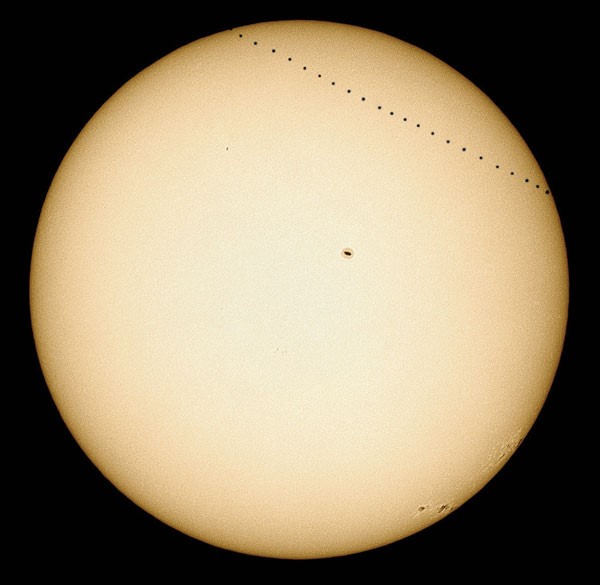
As seen in the figure, Mercury’s image on the Sun’s disk is far smaller than even a sunspot.
Though he planned to measure the transit times, Gassendi inadvertently messed up communications with his assistant, so that his observations were useless for the AU calculation. They did however help refine Kepler’s calculation, as well as establish the fact that reflected sunlight can make a planet appear much larger than it is. Actual planetary sizes were far smaller than previously thought, and consequently, the Solar system was far larger than previous estimates.
Edmond Halley and the Transit of Venus
Half a century after Gassendi, the English astronomer Edmond Halley (of Halley’s Comet fame) observed the transit of Mercury of 1677, which inspired him to write a paper on how transits of the internal planets could be employed to determine the AU accurately.
As shown in figure (a), two observers watching the same transit from different locations on the earth (E) would see a small shift in the path traced by the planet across the Sun’s disk. The difference between these paths can be used to determine the distance of the planet from the earth by the parallax method, and from that, the AU.
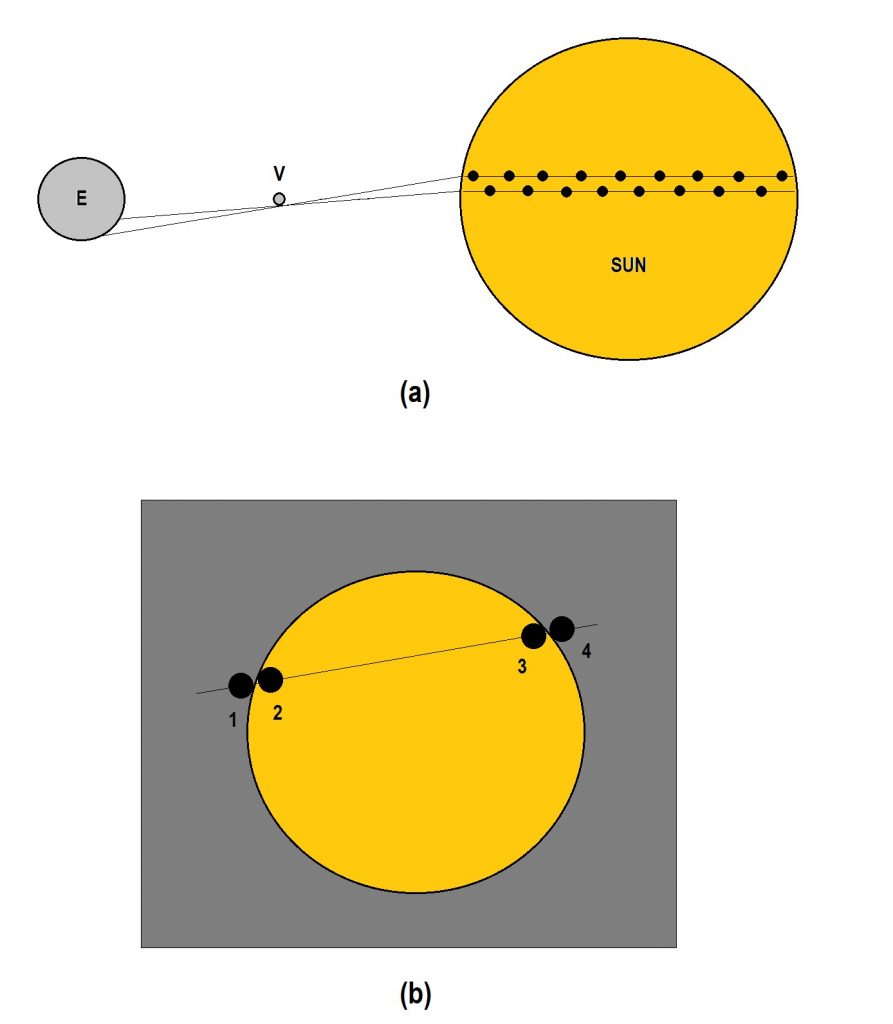
Of course, this difference, even for very distant geographical locations on the earth, would be very small, and so, there was very little margin for error. The times when the planet entered and exited the Sun’s disk would have to be measured very, very, precisely.
As shown in figure (b), four times were sought: 1) first ingress, when the planet’s rim touches the outer rim of the Sun; 2) second ingress, when the planet’s rim touches the Sun’s inner rim; 3) first egress, when the planet’s rim touches the Sun’s inner rim; 4) second egress, when the planet’s rim touches the Sun’s outer rim. These four times, and the observer’s exact geographical location, were the main items needed.
Halley favored Venus over Mercury because Venus was larger, closer to the earth, and slower moving than Mercury. Venus’s larger silhouette would better aid observation, it’s greater parallax would be easier to measure, and its slower speed would give longer observation times. There was, however, a problem. While Mercury transits are plentiful, those of Venus are very rare. Venus transits occur in pairs, 8 years apart, with each pair occurring a hundred years after the previous pair. He calculated that the next Venus transit pair would occur in 1761 and 1769. This was 1716. With another 50 years to go, Halley realized that he would not be alive to witness these transits of Venus. In line with Kepler’s appeal, he too published a fervent appeal:
I recommend it therefore, again and again, to those curious astronomers who, when I am dead, will have an opportunity of observing these things, that they would remember this my admonition, and diligently apply themselves with all their might in making this observation, and I earnestly wish them all imaginable success: in the first place, that they may not by the unseasonable obscurity of a cloudy sky be deprived of this most desirable sight, and then, that having ascertained with more exactness the magnitude of the planetary orbits, it may redound to their immortal fame and glory1.
Immortal fame and glory, did you say? What red-blooded young man can let an opportunity like that pass by!
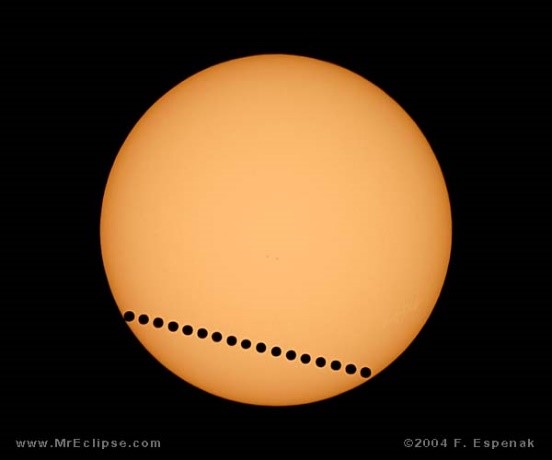
Readers may note that nowadays the Earth-Venus distance is measured by radar. Radar waves are sent from Earth to Venus and the bounced waves collected, noting the time it took (usually about 5 minutes for the round trip). Since radar waves travel at the speed of light, the distance travelled can be easily calculated.
The Transit Hunters
When young Guillaume first arrived in Paris from his hometown, he was not sure what career path he should choose. He began by studying theology and thought of becoming a priest. He would sometimes come to the Royal College to hear lectures on astronomy by the celebrated Prof. DeLisle, and it was during these sessions that he realized his true passion.
On the suggestion of a friend he visited the Paris Observatory along with DeLisle and presented himself to the Director Jacques Cassini, informing him of his interest in astronomy. Cassini proposed that he come and stay at the Observatory and work under the guidance of his son Cassini De Thury. And thus it was that young LeGentil found himself fully devoted to the study of the heavens.
The new astronomer quickly became familiar with the use of instruments and of making the most delicate observations and the most difficult calculations. His hard work paid off and he was appointed to the prestigious Royal Academy of Sciences in 1753 where he became a regular contributor of research on various aspects of astronomy.
Then, in 1760, came the announcement that the long-awaited transit of Venus was at hand, the exact date being June 6, 1761. Enterprising and courageous men of science from various nations were making preparations for voyages to far corners of the globe to capture the event. LeGentil found himself irresistibly attracted to the prospect of leaving his mark on this grandest of problems in astronomy.
He volunteered and obtained the honor of being among the travelers nominated by the Academy by order of the King. Father Chappe was destined for Siberia; Father Pingre for Rodrigues Island, near Madagascar; Mason for the Cape of Good Hope, in South Africa; and LeGentil for Pondicherry in India.
And thus, at age 35, LeGentil set out on the voyage of a lifetime, blissfully unaware of the caprices of fate that lay in store for him.
The Travels of Monsieur LeGentil
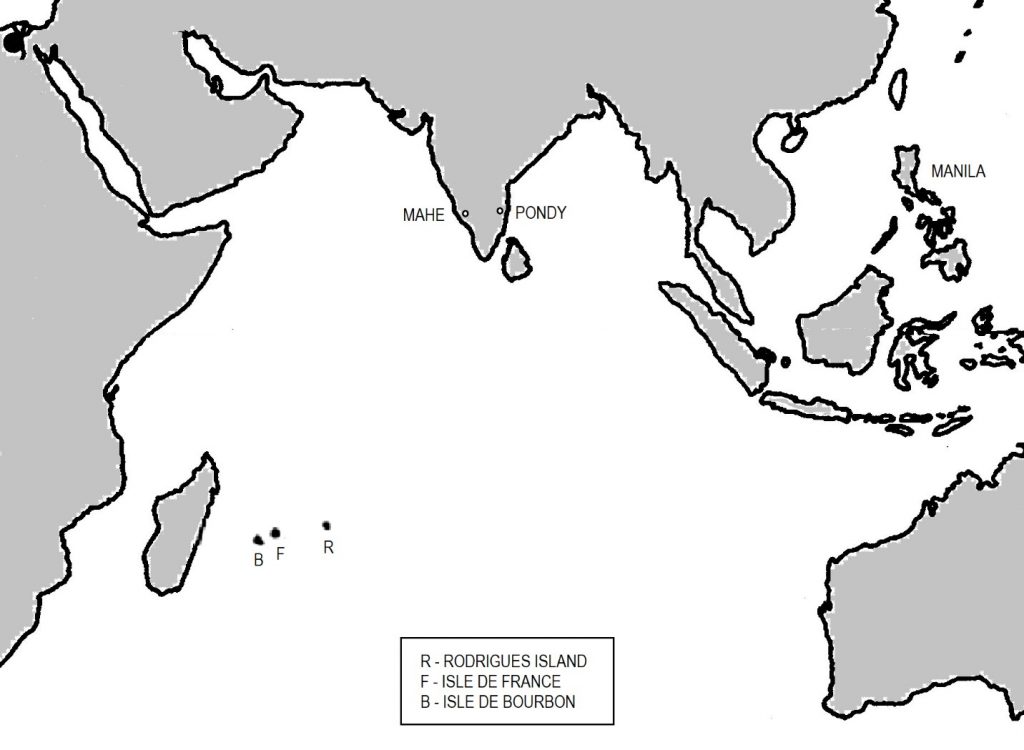
He started out in March 1760, more than a year ahead of the transit, to account for any delays that may occur during the long sea voyage. Voyages to India from Europe in those pre-suez-canal days required ships to sail around the Cape of Good Hope in Africa.
The first leg of the journey, from the Atlantic to the Indian Ocean, was long but uneventful, and he arrived on the 10th of July at the Isle-of-France (now Mauritius) in the Indian Ocean. There, he received the bad news that hostilities had broken out between the French and the English in India, and no ships would be embarking to Pondicherry. After several months of waiting, during which he also fell sick, and with the transit date drawing near, he decided to abandon Pondicherry and join Father Pingre at the Rodrigues Island, a few hundred miles east of the Isle-of-France.
He was all set to depart when a French frigate arrived at the Isle in February with important news to be relayed to Pondicherry immediately. Thinking that his luck was finally turning, LeGentil abandoned his plans for Rodrigues Island and embarked on the frigate. He was assured that it would take two months on the outside to reach Pondicherry, which would land him there in mid-May – within a couple weeks of the transit.
For some time it was smooth sailing with a favorable wind. As they crossed the equator, however, the winds became unfavorable, and blew them off course. They wandered around the seas of Africa and Arabia for several weeks before finally nearing Mahe (another French colony) on the Malabar coast on the 24th of May. From passing ships they learnt that Mahe, as well as Pondicherry, was now in English hands.
The captain decided, much to LeGentil’s regret, to return to the Isle-of-France. And so it happened that our astronomer observed the transit of Venus of June 1761 on the open sea, on the unsteady deck of a moving frigate. He had little idea of his exact position, or the exact time, and so his observations were of little value. It must have been especially exasperating, since the weather, that nemesis of all astronomers, was exceedingly fine that day.
The pain of having needlessly made a voyage of thousands of miles for no account must have been upon him, and it was on this occasion that he made up his mind, like the terrible oath of Bhishma, to sacrifice 8 years of his life by staying put till the next Venus transit, which would be the last one for another 105 years.
Never a man to sit idle, LeGentil spent the time usefully in mapping out geographically various locations near the Isle-of-France and making studies on natural history, physics, astronomy, navigation, winds and tides. He made several voyages to the Isle-of-Bourbon, and Madagascar, whose beauty struck him greatly. In this manner time passed till 1765, when it was time to think about the next transit, which was to occur on June 3, 1769.
Having learnt his lesson, this time he made alternate plans as well. Apart from Pondicherry on the Coromandel coast, there was Mahe on the Malabar coast, and Manila in the Philippines. He crossed out Mahe, since June on the Malabar coast was the time of the monsoon. Manila was preferable to Pondicherry as the Sun would be higher there during the transit, and so he began to look for a passage there, and was told he could reach Manila via China.
As luck would have it, a Spanish warship bound directly for Manila had docked at the Isle-of-France and the captain agreed to accept LeGentil onboard. And so, in May 1766, LeGentil bade what he considered a final goodbye to the Isle-of-France and started for Manila. He would not be returning, so he thought. After observing the transit in Manila, he would reach Europe via the pacific, sailing eastwards from Manila.
Upon reaching Manila, he had a difficult time with the Spanish Governor there, who was not quite convinced with his story about transits and such, and accused him of forging letters of recommendation. LeGentil hastily applied for a letter of recommendation from the King of Spain. While he was waiting for a response, he received information that Pondicherry was once again in French hands, and that he should proceed there immediately.
And thus it was that LeGentil finally set foot in Pondicherry on 27 March 1768, a full eight years after he embarked on that quest.
Pondicherry
He was received cordially by the French Governor, who saw to the comforts of the distinguished guest, and directed his engineers to find a place for LeGentil to set up his Observatory. The effects of the war in the form of ruined buildings can be seen in this drawing of Pondicherry from LeGentil’s memoirs.
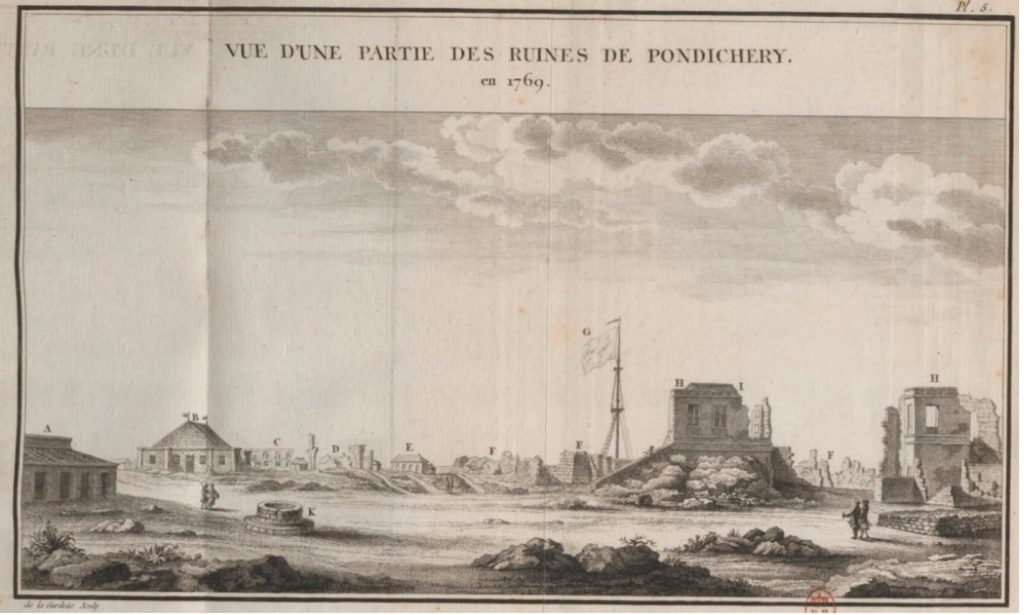
He ended up building his Observatory and living quarters in the ruin seen on the right side of the flagstaff in the middle of the picture. Under that building was a strong vault, which also served as an ammunition depot for explosives!
It is true however that the basement of my Observatory served also, for over six weeks, as a magazine for more than sixty thousand weight of powder.
By mid-July of 1768 he was fully settled. His instruments were cleaned and ready, and he had begun a series of observations of the Sun, Moon and the planets, as well as the determination of the exact longitude and latitude of Pondicherry. There was still another year to go for the transit, but now that he had finally arrived, he was content to wait patiently for it.
With my soul content and satisfied, I await with tranquility until the approaching ecliptic conjunction of Venus with the sun comes to terminate my academic studies.
It was during this leisure time that he started taking an interest in Indian astronomy.
The Tirvalour Tables
Even before he landed in Pondicherry, LeGentil had heard much about Indian astronomy.
Before my departure, I had heard from some of the famous French voyageurs that they had witnessed very accurate predictions of the eclipses of the Sun and the Moon by the Indians. For seven years since I was in the seas of India, all the people who had been at Pondicherry, and whom I saw daily, had told me so much about the wonders of the calculations of the Indians on the eclipses of the Sun and the Moon, and the great exactness with which they matched these eclipses, that my first care upon reaching Pondicherry was to verify the facts for myself.
I learnt that this calculation was a secret confined to the community of the Brahmin priests; a secret which belonged to those of their religion, of which the Brahmins alone were the repositories, and that no one, other than these philosophers, could understand these computations. I was even assured that not all Brahmins possessed this secret; that in all India there was only a very small number of them who made these complex calculations; that this science was passed in the family from father to son, without ever passing even to other Brahmin families.
Soon upon his arrival he befriended a Christian Tamil named Mariappa, who spoke good French. Having expressed his desire to learn the Indian technique of calculating eclipses, he was informed that the Brahmins would never part with their secret. Mariappa, however, knew a man related to the Royal family, who had learnt some of this art from a Brahmin, and that he himself has tried to learn it from this man, but not very successfully.
Mariappa arranged a meeting between LeGentil and the man, who was named Gnana Muttu. LeGentil asked for a demonstration and proposed that he calculate in his presence the total lunar eclipse of Dec. 1768. Gnana Muttu then pulled out a bag of cowries, and a book of palm leaves, and began calculating.
He sat down on the floor, and by handling these cowries with a singular speed, and consulting his little booklet from time to time, he gave me all the phases of the eclipse in less than three quarters of an hour. I compared this calculation with that of the ephemerides, and I noticed enough conformity to make me admire the method of this man. Having given him other eclipses to calculate, he did not take more time for them than he had done for the first one.
Impressed, LeGentil asked if he would be willing to teach him the technique.
I spoke of it to the Indian, who replied that he would do so willingly, and having asked him how long it would take for me to learn how to calculate an eclipse of the Moon, he replied, with an air of self-importance, that if I had any aptitude, I could, with hard work, come to an end in four months’ time.
It must have been galling for an astronomer of the Royal Academy of Sciences to be spoken to like a novice schoolboy! In any case, he set up a time, one hour every evening, when Gnana Muttu would come to his house and impart lessons on the Indian method of eclipse calculation.
By and by, with some help from the Christian Tamil, LeGentil mastered the techniques. He describes them in detail in Chapter-III of his memoirs, which is now an important document in the History of Indian Astronomy, as it represents the very first account of a European obtaining astronomical principles directly from the Indians. This account is often referred to as The Tirvalour Tables by scholars. His freely expressed opinions on various aspects of Indian astronomy make for interesting reading.
LeGentil on the heights reached by Indian astronomy in ancient times, and its stagnation thereafter:
The death of this Prince Salivaganam would therefore fall in the year 78 AD, which seems to prove that from that time the Brahmins were in this part of India, and that they already knew how to calculate the eclipses of the Sun and the Moon at a time when the north of Europe was still plunged in the darkness of ignorance and barbarism.
But what progress has been made since then in Astronomy amongst us, while the Brahmins are today exactly what they were since the time of Salivaganam, seventeen hundred years ago!
If and whether this indolence can be attributed to physical causes, such as climate, or whether there are moral causes, it is certain that the Brahmins do not think of extending their knowledge. All whom I met seemed to be rather uncomfortable with perfecting their calculations, or doing any astronomical observation, or any other kind of research for this purpose. They even imagine that the activities we do in our countries are a continuation of our ignorance, and that we come to educate ourselves to their land, in a science that we do not know in Europe.
On the Indian method of astronomical computation:
Their rules of astronomical calculations are in enigmatic verses, which they know by heart. By this means, they do not need tables of data. By means of those verses, which we see them recite as they calculate (as we do our formulas), and by means of their cowries, they make these calculations of the eclipses of the Sun and the Moon with the greatest quickness.
They perform their calculations with a singular speed and ease, without pen or pencil. They replace writing with cowries (a sort of shell), which they place on a table, like our tokens, and most often on the ground. This method of calculating seems to me to have its advantages, in that it is much more prompt and more expeditious than ours. But at the same time, it has a very great inconvenience. There is no way of going back on the calculations, much less of keeping them, since we erase as we advance. If we have, unfortunately, made a mistake, we must start again, from the beginning.
But it is very rare that they are mistaken. They work with a singular coolness; a calmness and tranquility of which we are incapable, which enables them to avoid the mistakes which we Europeans would not fail to make in their place. It therefore appears that we must, among other things, keep each one to our method. It seems that theirs was made only for them.
On the accuracy of Indian predictions:
As to the exactness of this method, the agreement with observation has appeared to me quite singular, especially in lunar eclipses. The error, in several which I have calculated, amounts to no more than 25 minutes of time.
Apart from the eclipse calculation, some other points on Indian astronomy LeGentil discovered are as follows. Readers may note that some of these items are the same as determined by Euler a few decades earlier, from the Tranquebar Notes. This similarity is not surprising, because Tranquebar (Tharangambadi), Tirvalour and Pondicherry are all in close proximity in the Tamil province.
- The Indian Sidereal year has a duration of 365 days, 6 hours, 12 minutes and 30 seconds. This is in excess of 2 minutes from the modern value.
- The Indians employ a precession value of 54 sec/year, which is close to the modern value of 50 sec/year, and far more accurate than the Greek estimate of 36 sec/year.
- The Indian Tropical Year has a duration of 365 days, 5 hours, 50 minutes and 54 seconds. This is in excess of the modern value by 2 minutes, but is more accurate than that of the Greeks by over 4 minutes.
| Tropical Year Length | |
| Greek | 365 days, 05:55:15 |
| Indian | 365 days, 05:50:54 |
| Modern | 365 days, 05:48:46 |
- The Indian months do not all have the same duration. The month of June is the longest of all and the month of December the shortest. European months are also unequal, but those of the Indians are so in a more singular manner. European months are composed of a whole number of days; that of the Indians contain days, hours and minutes.
- The Indians are aware of the variation in the Sun’s motion – of its apogee and perigee.
- The Indian Zodiac of 27 divisions bears the stamp of great antiquity, which, being related to the movement of the moon, is the most natural and probably the first Zodiac to have been created.
LeGentil’s Summary on Indian astronomy:
I will content myself with the following remarks, without pretending to make any assertions:
(a) That astronomy, imperfect as it is in India, is certainly more perfect than it was found in China by our missionaries.
(b) That this astronomy appears to me to come from Chaldea.
(c) That there exists on the coast of Coromandel, among the Tamils, a tradition which seems to prove that the Chinese have come to trade at this coast, and that they even possessed a colony there. That the Chinese worshiped there the Gods of this country, which they took with them to China. And that it might well be that the Chinese had learned something of the astronomy of the Indians, but had disfigured what little they knew of it.
The Venus Transit of 1769
One month before the transit, LeGentil received the letter of recommendation from the Spanish Court allowing him to observe at Manila. It had gone circulating around the world for two years before finally reaching him! But it was too late for that now.
The English at Madras, coming to know of his quest, sent him an excellent achromatic telescope. Even enemies must come together in matters of scientific progress! Everything was set, and LeGentil waited with impatience for the transit date of June 3rd (4th in India).
The whole of May and the beginning of June had been beautiful, with clear skies. On the evening prior to the transit LeGentil invited the Governor to his observatory and they observed together the satellites of Jupiter using the English telescope.
The next day …
Sunday the fourth, having awakened at two o’clock in the morning, I heard the sand-bar moaning in the south-east. I regarded this as a good omen because the wind from the south-east is the broom of the coast and it always brings serenity. But curiosity having led me to get up a moment afterwards, I saw with the greatest astonishment that the sky was covered everywhere in clouds. Besides, there was a profound calm. From that moment I felt doomed.
Around five o’clock, the wind began to blow a little which gave me some hope that the breeze might clear the sky. However, in the north and north-east the clouds did not move. I still heard the bar in the north-east, so I was between hope and fear. Soon, however, a gust approached. It blew with great fury. The great clouds, which were till them motionless, began to move. They spread out now to form a second layer. The sea was white with foam, and the air darkened with eddies of sand and dust, with the force of the wind rising. This terrible squall lasted till six o’clock. Then the winds died down, but the clouds remained. At three minutes before seven o’clock, the time of the beginning of the transit, a light whiteness was seen in the sky which gave a hint of the sun’s position, but nothing could be seen in the telescope.
He had missed the all-important beginning of the transit. As if to mock him, the weather cleared soon thereafter and was fine for the rest of the day.
This is the fate which often awaits astronomers. I had gone more than ten thousand leagues. It seemed that I had crossed such a great expanse of seas, exiling myself from my native land, only to be the spectator of a fatal cloud which came to place itself before the sun at the precise moment of my observation, to carry off from me the fruits of my pains and of my fatigues…
To make matters worse, he soon learned that in Manila, which he had left almost in spite of himself, the sky had been clear.
Return to France
LeGentil writes that for two weeks after the debacle he was in a state of singular dejection. He could not bring himself to pick up his pen and write anything in his journal. Eventually, he accepted his fate, and, seeing that there would be no more Venus transits for a hundred years, began to think for going home.
Towards September he fell seriously ill, likely due to fatigue and stress, and had to delay his departure until the following Spring of 1770. Though not fully recovered, he hastened to leave Pondicherry by the first available ship. The vessel would be travelling via his old nemesis, the Isle-of-France. He still had his collection of Natural History stored in boxes there, which he meant to pick up on the way back.
In November 1770, he left the Isle-of-France on a French ship (hopefully his last goodbye) along with his precious Natural History collection. A little out to sea, however, they faced a hurricane that badly damaged the ship, and only with the greatest difficulty did they limp back to the Isle-of-France again. At this point LeGentil writes that he despaired of ever reaching France again. In the melee during the hurricane, he also lost the boxes of his collections.
The following March, he obtained passage on a Spanish frigate which finally placed him at the Spanish port city of Cadiz on the 1st of August, 1771. Tired of the sea, he decided to travel to Paris over ground, and arrived there eleven and a half years after leaving it.
On reaching home he found to his amazement that everyone thought him dead for several years. His legal prosecutor, with whom he had been in constant communication, never showed his letters to anyone. His heirs, in fact, were wrangling on distributing his properties, before he surprised everyone by appearing in person.
Postscript
It appears that after his return to France fate finally relented its assault on our protagonist. He married, and had a daughter, who became the object of his deepest affections. The last two decades of his life were spent in happy and peaceful family life, working at the Paris Observatory, and writing his memoirs. A kindly fate also saw it fit to carry him away at age 67, one year before the French Revolution, sparing him the horrors that followed, including the destruction of his beloved Academy.
Jean-Dominique Comte de Cassini, the last of the great Cassini’s, wrote in his Eulogy for LeGentil:
His face did not prejudice one in his favor; but, animated by conversation, it took on an expression of wit and originality which was pleasing. In his voyages on the sea he had contracted a little savagery and abruptness, but without rudeness; for in intimacy he was friendly and gentle. Finally, to complete the picture, we shall say that he was a good member of the Academy, a very good husband, and an excellent father.
References
- Lomb, Nick, Transit of Venus: 1631 to the Present, The Experiment Publishing, New York, 2011.
- Sawyer Hogg, H., Out of Old Books – Le Gentil and the Transits of Venus, 1761 and 1769, Journal of the Royal Astronomical Society of Canada, Vol. 45, parts I, II, III.
- Guillaume Joseph Hyacinthe Jean Baptiste Le Gentil, Voyage dans les mers de l’Inde, Paris, 1779.
Featured Image: Frontiers Blog
Disclaimer: The opinions expressed within this article are the personal opinions of the author. IndiaFacts does not assume any responsibility or liability for the accuracy, completeness, suitability, or validity of any information in this article.
Anil Narayanan is former scientist at ISRO, now working as a consultant in Washington DC. His hobby is ancient astronomy to which he devotes most of his spare time. He is the author of the book ‘History of Indian Astronomy: The Siamese Manuscript’.

